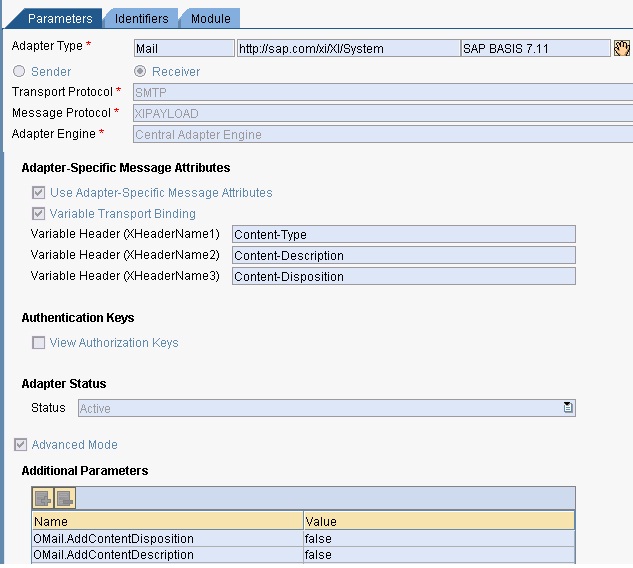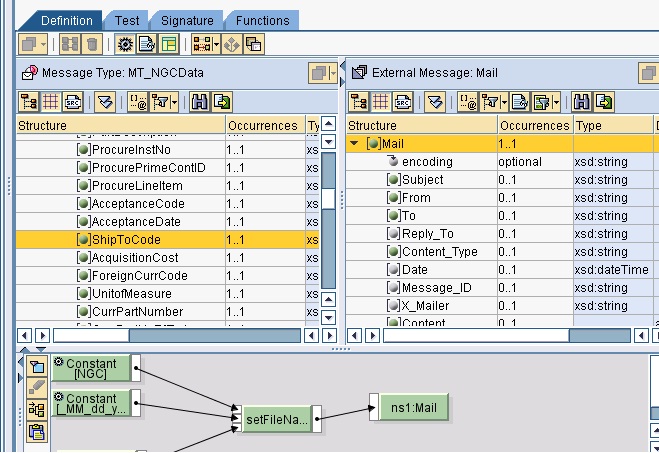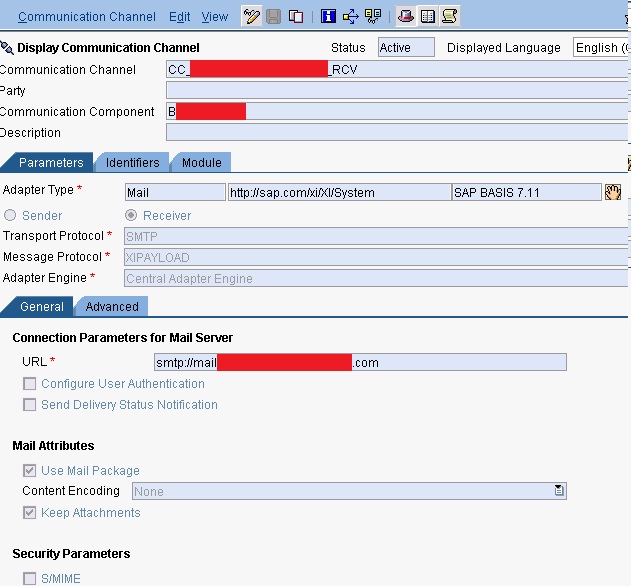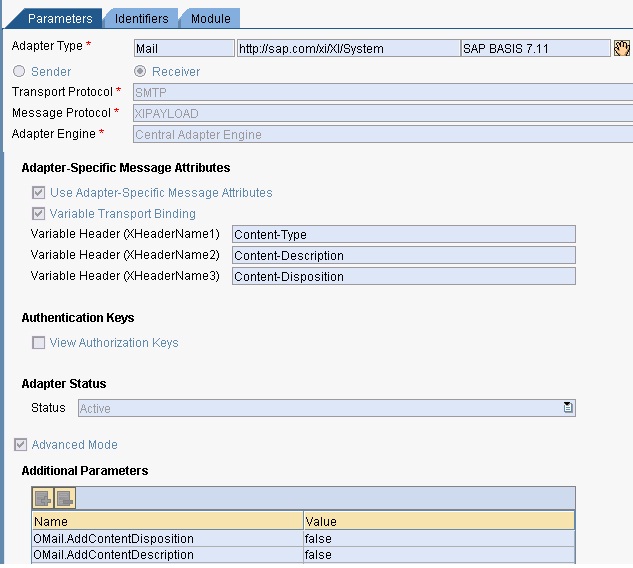
- SAP Community
- Products and Technology
- Technology
- Technology Blogs by Members
- Handling attachment as text file with Receiver Mai...
- Subscribe to RSS Feed
- Mark as New
- Mark as Read
- Bookmark
- Subscribe
- Printer Friendly Page
- Report Inappropriate Content
I just share my experience which I got while doing the development to send the payload (Text file) as attachment with SMTP adapter at the receiver communication channel.
This blog explains how the XML to plain text file conversion and attachment name change can be achieved.
The main part explained here is, XML to flat file conversion and payload name change. Please note that this document explains only about the important configurations.
Prerequisites:
- Developer should have basic knowledge on PI ESR and ID developments.
- Should have the mail package schema downloaded (if mail package is used for the development)
Here two concepts are explained in this blog
- Without mail package type
- With mail package type
CONCEPT(A): Without Mail Package Type (Target structure can be any type or compatible type for content conversion)

(Concept: A1). Static Naming for the File (File Conversion using Modules/Beans):
Below is the channel parameters to get the file name “NGC.txt”.


Select the “Keep attachments” check box in the receiver communication channel.

Below are the module tab parameters:
1 AF_Modules/StrictXml2PlainBean Local Enterprise Bean 0
2 AF_Modules/PayloadSwapBean Local Enterprise Bean 1
3 AF_Modules/MessageTransformBean Local Enterprise Bean 2
4 sap.com/com.sap.aii.adapter.mail.app/XIMailAdapterBean Local Enterprise Bean mail
0 Data.fieldSeparator ^
0 Header.fieldSeparator ^
0 Trailer.fieldSeparator ^
0 recordTypes Header,Data,Trailer
1 swap.keyName payload-name
1 swap.keyValue MainDocument
2 Transform.ContentDescription NGC
2 Transform.ContentDisposition attachment;filename=NGC.txt
2 Transform.ContentType text/plain

Variables Transport Binding: (Mime type related setting)
XHeaderName1 : Content-Type
XHeaderName2 : Content-Description
XHeaderName3 : Content-Disposition
Additional Parameters:
OMail.AddContentDisposition false
OMail.AddContentDescription false
OMail.AddContentType false
(Concept: A2) Dynamic File Names:
Usually, file name can be changed using java Code (UDF) with dynamic configuration related API or logic. This file name change works only if we don’t use content conversion.
Note: If we combine dynamic configuration UDF and content conversion modules in the CC, dynamic text file name is not working (File name will be always MainDocument).
Create the below UDF and assign it to root node of target structure (in Message Mapping):
public String setFilename(String strPrefix, String strSuffixDateFormat, String strFileExtension, Container container) throws StreamTransformationException
{
MappingTrace objTrace = container.getTrace();
DynamicConfiguration objDynConfig;
DynamicConfigurationKey objDCKey;
final String NAMESPACE = "http://sap.com/xi/XI/System/Mail";
final String ATTRIBUTE3 = "XHeaderName3"; //ContentDisposition
final String ATTRIBUTE1 = "XHeaderName1"; //ContentType
final String ATTRIBUTE2 = "XHeaderName2"; //ContentDescription
Date objDate = new Date();
String strFomatedDate = "";
String strFileName = "";
SimpleDateFormat objSDF = new SimpleDateFormat(strSuffixDateFormat);
try
{
objDynConfig = (DynamicConfiguration) container.getTransformationParameters().
get(StreamTransformationConstants.DYNAMIC_CONFIGURATION );
objDCKey = DynamicConfigurationKey.create(NAMESPACE, ATTRIBUTE3);
//get the current date and time for file name
strFomatedDate = objSDF.format(objDate);
//setting the file name dynamically
strFileName = strPrefix + strFomatedDate + strFileExtension;
strFileName = "attachment; filename=" + strFileName;
objTrace.addWarning(strFileName);
objDynConfig.put(objDCKey, strFileName);
strFileName = "text/plain;";
objDCKey = DynamicConfigurationKey.create(NAMESPACE, ATTRIBUTE1);
objTrace.addWarning(strFileName);
objDynConfig.put(objDCKey, strFileName);
strFileName = "NGC";
objDCKey = DynamicConfigurationKey.create(NAMESPACE, ATTRIBUTE2);
objTrace.addWarning(strFileName);
- objDynConfig.put(objDCKey, strFileName);
- container.setParameter(StreamTransformationConstants.DYNAMIC_CONFIGURATION, objDynConfig);
}
catch (Exception objException)
{
objTrace.addWarning( objException.getMessage() );
}
return "";
}
Configure the Receiver channel parameters are as below to enable adapter specific settings:
Select the “Keep attachments” check box in the receiver communication channel.


Module tab parameters:
1 AF_Modules/StrictXml2PlainBean Local Enterprise Bean 0
2 sap.com/com.sap.aii.adapter.mail.app/XIMailAdapterBean Local Enterprise Bean mail
0 Data.fieldSeparator ^
0 Header.fieldSeparator ^
0 Trailer.fieldSeparator ^
0 recordTypes Header,Data,Trailer
Additional Parameters:
- OMail.AddContentDisposition false
- OMail.AddContentDescription false
- OMail.AddContentType false
So, I would suggest to go for CONCEPT (B) if dynamic file name and content conversion needs to be applied same time...
CONCEPT (B): Target structure should be MAIL package:
Use the mail package external definition file as the target message type (Attached in this blog).
Create an UDF and assign it to target structure (in Message Mapping):
public String setFilename(String strPrefix, String strSuffixDateFormat, String strFileExtension, Container container) throws StreamTransformationException
{
MappingTrace objTrace = container.getTrace();
DynamicConfiguration objDynConfig;
DynamicConfigurationKey objDCKey;
final String NAMESPACE = "http://sap.com/xi/XI/System/Mail";
final String ATTRIBUTE3 = "XHeaderName3"; //ContentDisposition
final String ATTRIBUTE1 = "XHeaderName1"; //ContentType
final String ATTRIBUTE2 = "XHeaderName2"; //ContentDescription
Date objDate = new Date();
String strFomatedDate = "";
String strFileName = "";
SimpleDateFormat objSDF = new SimpleDateFormat(strSuffixDateFormat);
try
{
objDynConfig = (DynamicConfiguration) container.getTransformationParameters().
get(StreamTransformationConstants.DYNAMIC_CONFIGURATION );
objDCKey = DynamicConfigurationKey.create(NAMESPACE, ATTRIBUTE3);
//get the current date and time for file name
strFomatedDate = objSDF.format(objDate);
//setting the file name dynamically
strFileName = strPrefix + strFomatedDate + strFileExtension;
strFileName = "attachment; filename=" + strFileName;
objTrace.addWarning(strFileName);
objDynConfig.put(objDCKey, strFileName);
strFileName = "text/plain;";
objDCKey = DynamicConfigurationKey.create(NAMESPACE, ATTRIBUTE1);
objTrace.addWarning(strFileName);
objDynConfig.put(objDCKey, strFileName);
strFileName = "NGC";
objDCKey = DynamicConfigurationKey.create(NAMESPACE, ATTRIBUTE2);
objTrace.addWarning(strFileName);
- objDynConfig.put(objDCKey, strFileName);
- container.setParameter(StreamTransformationConstants.DYNAMIC_CONFIGURATION, objDynConfig);
}
catch (Exception objException)
{
objTrace.addWarning( objException.getMessage() );
}
return "";
}
Assign the file name UDF on the root node of target message (in Message Mapping):

Here, prepare the flat file records and assign fill it to content fled of message (separated with the character ‘\n’ for the new line).
Configure the Receiver channel parameters are as below to enable adapter specific settings:
Select the “Use Mail Package” and “Keep attachments” check boxes in the receiver communication channel.


Variables Transport Binding: (Mime type related setting)
XHeaderName1 : Content-Type
XHeaderName2 : Content-Description
XHeaderName3 : Content-Disposition
Additional Parameters
OMail.AddContentDisposition false
OMail.AddContentDescription false
OMail.AddContentType false
- SAP Managed Tags:
- Cloud Integration
You must be a registered user to add a comment. If you've already registered, sign in. Otherwise, register and sign in.
-
"automatische backups"
1 -
"regelmäßige sicherung"
1 -
505 Technology Updates 53
1 -
ABAP
14 -
ABAP API
1 -
ABAP CDS Views
2 -
ABAP CDS Views - BW Extraction
1 -
ABAP CDS Views - CDC (Change Data Capture)
1 -
ABAP class
2 -
ABAP Cloud
2 -
ABAP Development
5 -
ABAP in Eclipse
1 -
ABAP Platform Trial
1 -
ABAP Programming
2 -
abap technical
1 -
access data from SAP Datasphere directly from Snowflake
1 -
Access data from SAP datasphere to Qliksense
1 -
Accrual
1 -
action
1 -
adapter modules
1 -
Addon
1 -
Adobe Document Services
1 -
ADS
1 -
ADS Config
1 -
ADS with ABAP
1 -
ADS with Java
1 -
ADT
2 -
Advance Shipping and Receiving
1 -
Advanced Event Mesh
3 -
AEM
1 -
AI
7 -
AI Launchpad
1 -
AI Projects
1 -
AIML
9 -
Alert in Sap analytical cloud
1 -
Amazon S3
1 -
Analytical Dataset
1 -
Analytical Model
1 -
Analytics
1 -
Analyze Workload Data
1 -
annotations
1 -
API
1 -
API and Integration
3 -
API Call
2 -
Application Architecture
1 -
Application Development
5 -
Application Development for SAP HANA Cloud
3 -
Applications and Business Processes (AP)
1 -
Artificial Intelligence
1 -
Artificial Intelligence (AI)
4 -
Artificial Intelligence (AI) 1 Business Trends 363 Business Trends 8 Digital Transformation with Cloud ERP (DT) 1 Event Information 462 Event Information 15 Expert Insights 114 Expert Insights 76 Life at SAP 418 Life at SAP 1 Product Updates 4
1 -
Artificial Intelligence (AI) blockchain Data & Analytics
1 -
Artificial Intelligence (AI) blockchain Data & Analytics Intelligent Enterprise
1 -
Artificial Intelligence (AI) blockchain Data & Analytics Intelligent Enterprise Oil Gas IoT Exploration Production
1 -
Artificial Intelligence (AI) blockchain Data & Analytics Intelligent Enterprise sustainability responsibility esg social compliance cybersecurity risk
1 -
ASE
1 -
ASR
2 -
ASUG
1 -
Attachments
1 -
Authorisations
1 -
Automating Processes
1 -
Automation
1 -
aws
2 -
Azure
1 -
Azure AI Studio
1 -
B2B Integration
1 -
Backorder Processing
1 -
Backup
1 -
Backup and Recovery
1 -
Backup schedule
1 -
BADI_MATERIAL_CHECK error message
1 -
Bank
1 -
BAS
1 -
basis
2 -
Basis Monitoring & Tcodes with Key notes
2 -
Batch Management
1 -
BDC
1 -
Best Practice
1 -
bitcoin
1 -
Blockchain
3 -
BOP in aATP
1 -
BOP Segments
1 -
BOP Strategies
1 -
BOP Variant
1 -
BPC
1 -
BPC LIVE
1 -
BTP
11 -
BTP Destination
2 -
Business AI
1 -
Business and IT Integration
1 -
Business application stu
1 -
Business Architecture
1 -
Business Communication Services
1 -
Business Continuity
1 -
Business Data Fabric
3 -
Business Partner
12 -
Business Partner Master Data
10 -
Business Technology Platform
2 -
Business Trends
1 -
CA
1 -
calculation view
1 -
CAP
2 -
Capgemini
1 -
Catalyst for Efficiency: Revolutionizing SAP Integration Suite with Artificial Intelligence (AI) and
1 -
CCMS
2 -
CDQ
12 -
CDS
2 -
Cental Finance
1 -
Certificates
1 -
CFL
1 -
Change Management
1 -
chatbot
1 -
chatgpt
3 -
CL_SALV_TABLE
2 -
Class Runner
1 -
Classrunner
1 -
Cloud ALM Monitoring
1 -
Cloud ALM Operations
1 -
cloud connector
1 -
Cloud Extensibility
1 -
Cloud Foundry
3 -
Cloud Integration
6 -
Cloud Platform Integration
2 -
cloudalm
1 -
communication
1 -
Compensation Information Management
1 -
Compensation Management
1 -
Compliance
1 -
Compound Employee API
1 -
Configuration
1 -
Connectors
1 -
Conversion
1 -
Cosine similarity
1 -
cryptocurrency
1 -
CSI
1 -
ctms
1 -
Custom chatbot
3 -
Custom Destination Service
1 -
custom fields
1 -
Customer Experience
1 -
Customer Journey
1 -
Customizing
1 -
Cyber Security
2 -
Data
1 -
Data & Analytics
1 -
Data Aging
1 -
Data Analytics
2 -
Data and Analytics (DA)
1 -
Data Archiving
1 -
Data Back-up
1 -
Data Governance
5 -
Data Integration
2 -
Data Quality
12 -
Data Quality Management
12 -
Data Synchronization
1 -
data transfer
1 -
Data Unleashed
1 -
Data Value
8 -
database tables
1 -
Datasphere
2 -
datenbanksicherung
1 -
dba cockpit
1 -
dbacockpit
1 -
Debugging
2 -
Delimiting Pay Components
1 -
Delta Integrations
1 -
Destination
3 -
Destination Service
1 -
Developer extensibility
1 -
Developing with SAP Integration Suite
1 -
Devops
1 -
Digital Transformation
1 -
Documentation
1 -
Dot Product
1 -
DQM
1 -
dump database
1 -
dump transaction
1 -
e-Invoice
1 -
E4H Conversion
1 -
Eclipse ADT ABAP Development Tools
2 -
edoc
1 -
edocument
1 -
ELA
1 -
Embedded Consolidation
1 -
Embedding
1 -
Embeddings
1 -
Employee Central
1 -
Employee Central Payroll
1 -
Employee Central Time Off
1 -
Employee Information
1 -
Employee Rehires
1 -
Enable Now
1 -
Enable now manager
1 -
endpoint
1 -
Enhancement Request
1 -
Enterprise Architecture
1 -
ETL Business Analytics with SAP Signavio
1 -
Euclidean distance
1 -
Event Dates
1 -
Event Driven Architecture
1 -
Event Mesh
2 -
Event Reason
1 -
EventBasedIntegration
1 -
EWM
1 -
EWM Outbound configuration
1 -
EWM-TM-Integration
1 -
Existing Event Changes
1 -
Expand
1 -
Expert
2 -
Expert Insights
1 -
Fiori
14 -
Fiori Elements
2 -
Fiori SAPUI5
12 -
Flask
1 -
Full Stack
8 -
Funds Management
1 -
General
1 -
Generative AI
1 -
Getting Started
1 -
GitHub
8 -
Grants Management
1 -
groovy
1 -
GTP
1 -
HANA
5 -
HANA Cloud
2 -
Hana Cloud Database Integration
2 -
HANA DB
1 -
HANA XS Advanced
1 -
Historical Events
1 -
home labs
1 -
HowTo
1 -
HR Data Management
1 -
html5
8 -
idm
1 -
Implementation
1 -
input parameter
1 -
instant payments
1 -
integration
3 -
Integration Advisor
1 -
Integration Architecture
1 -
Integration Center
1 -
Integration Suite
1 -
intelligent enterprise
1 -
Java
1 -
job
1 -
Job Information Changes
1 -
Job-Related Events
1 -
Job_Event_Information
1 -
joule
4 -
Journal Entries
1 -
Just Ask
1 -
Kerberos for ABAP
8 -
Kerberos for JAVA
8 -
Launch Wizard
1 -
Learning Content
2 -
Life at SAP
1 -
lightning
1 -
Linear Regression SAP HANA Cloud
1 -
local tax regulations
1 -
LP
1 -
Machine Learning
2 -
Marketing
1 -
Master Data
3 -
Master Data Management
14 -
Maxdb
2 -
MDG
1 -
MDGM
1 -
MDM
1 -
Message box.
1 -
Messages on RF Device
1 -
Microservices Architecture
1 -
Microsoft Universal Print
1 -
Middleware Solutions
1 -
Migration
5 -
ML Model Development
1 -
Modeling in SAP HANA Cloud
8 -
Monitoring
3 -
MTA
1 -
Multi-Record Scenarios
1 -
Multiple Event Triggers
1 -
Neo
1 -
New Event Creation
1 -
New Feature
1 -
Newcomer
1 -
NodeJS
1 -
ODATA
2 -
OData APIs
1 -
odatav2
1 -
ODATAV4
1 -
ODBC
1 -
ODBC Connection
1 -
Onpremise
1 -
open source
2 -
OpenAI API
1 -
Oracle
1 -
PaPM
1 -
PaPM Dynamic Data Copy through Writer function
1 -
PaPM Remote Call
1 -
PAS-C01
1 -
Pay Component Management
1 -
PGP
1 -
Pickle
1 -
PLANNING ARCHITECTURE
1 -
Popup in Sap analytical cloud
1 -
PostgrSQL
1 -
POSTMAN
1 -
Process Automation
2 -
Product Updates
4 -
PSM
1 -
Public Cloud
1 -
Python
4 -
Qlik
1 -
Qualtrics
1 -
RAP
3 -
RAP BO
2 -
Record Deletion
1 -
Recovery
1 -
recurring payments
1 -
redeply
1 -
Release
1 -
Remote Consumption Model
1 -
Replication Flows
1 -
Research
1 -
Resilience
1 -
REST
1 -
REST API
1 -
Retagging Required
1 -
Risk
1 -
Rolling Kernel Switch
1 -
route
1 -
rules
1 -
S4 HANA
1 -
S4 HANA Cloud
1 -
S4 HANA On-Premise
1 -
S4HANA
3 -
S4HANA_OP_2023
2 -
SAC
10 -
SAC PLANNING
9 -
SAP
4 -
SAP ABAP
1 -
SAP Advanced Event Mesh
1 -
SAP AI Core
8 -
SAP AI Launchpad
8 -
SAP Analytic Cloud Compass
1 -
Sap Analytical Cloud
1 -
SAP Analytics Cloud
4 -
SAP Analytics Cloud for Consolidation
1 -
SAP Analytics Cloud Story
1 -
SAP analytics clouds
1 -
SAP BAS
1 -
SAP Basis
6 -
SAP BODS
1 -
SAP BODS certification.
1 -
SAP BTP
20 -
SAP BTP Build Work Zone
2 -
SAP BTP Cloud Foundry
5 -
SAP BTP Costing
1 -
SAP BTP CTMS
1 -
SAP BTP Innovation
1 -
SAP BTP Migration Tool
1 -
SAP BTP SDK IOS
1 -
SAP Build
11 -
SAP Build App
1 -
SAP Build apps
1 -
SAP Build CodeJam
1 -
SAP Build Process Automation
3 -
SAP Build work zone
10 -
SAP Business Objects Platform
1 -
SAP Business Technology
2 -
SAP Business Technology Platform (XP)
1 -
sap bw
1 -
SAP CAP
1 -
SAP CDC
1 -
SAP CDP
1 -
SAP Certification
1 -
SAP Cloud ALM
4 -
SAP Cloud Application Programming Model
1 -
SAP Cloud Integration for Data Services
1 -
SAP cloud platform
8 -
SAP Companion
1 -
SAP CPI
3 -
SAP CPI (Cloud Platform Integration)
2 -
SAP CPI Discover tab
1 -
sap credential store
1 -
SAP Customer Data Cloud
1 -
SAP Customer Data Platform
1 -
SAP Data Intelligence
1 -
SAP Data Services
1 -
SAP DATABASE
1 -
SAP Dataspher to Non SAP BI tools
1 -
SAP Datasphere
9 -
SAP DRC
1 -
SAP EWM
1 -
SAP Fiori
2 -
SAP Fiori App Embedding
1 -
Sap Fiori Extension Project Using BAS
1 -
SAP GRC
1 -
SAP HANA
1 -
SAP HCM (Human Capital Management)
1 -
SAP HR Solutions
1 -
SAP IDM
1 -
SAP Integration Suite
9 -
SAP Integrations
4 -
SAP iRPA
2 -
SAP Learning Class
1 -
SAP Learning Hub
1 -
SAP Odata
2 -
SAP on Azure
1 -
SAP PartnerEdge
1 -
sap partners
1 -
SAP Password Reset
1 -
SAP PO Migration
1 -
SAP Prepackaged Content
1 -
SAP Process Automation
2 -
SAP Process Integration
2 -
SAP Process Orchestration
1 -
SAP S4HANA
2 -
SAP S4HANA Cloud
1 -
SAP S4HANA Cloud for Finance
1 -
SAP S4HANA Cloud private edition
1 -
SAP Sandbox
1 -
SAP STMS
1 -
SAP SuccessFactors
2 -
SAP SuccessFactors HXM Core
1 -
SAP Time
1 -
SAP TM
2 -
SAP Trading Partner Management
1 -
SAP UI5
1 -
SAP Upgrade
1 -
SAP-GUI
8 -
SAP_COM_0276
1 -
SAPBTP
1 -
SAPCPI
1 -
SAPEWM
1 -
sapmentors
1 -
saponaws
2 -
SAPUI5
4 -
schedule
1 -
Secure Login Client Setup
8 -
security
9 -
Selenium Testing
1 -
SEN
1 -
SEN Manager
1 -
service
1 -
SET_CELL_TYPE
1 -
SET_CELL_TYPE_COLUMN
1 -
SFTP scenario
2 -
Simplex
1 -
Single Sign On
8 -
Singlesource
1 -
SKLearn
1 -
soap
1 -
Software Development
1 -
SOLMAN
1 -
solman 7.2
2 -
Solution Manager
3 -
sp_dumpdb
1 -
sp_dumptrans
1 -
SQL
1 -
sql script
1 -
SSL
8 -
SSO
8 -
SuccessFactors
1 -
SuccessFactors Time Tracking
1 -
Sybase
1 -
system copy method
1 -
System owner
1 -
Table splitting
1 -
Tax Integration
1 -
Technical article
1 -
Technical articles
1 -
Technology Updates
1 -
Technology Updates
1 -
Technology_Updates
1 -
Threats
1 -
Time Collectors
1 -
Time Off
2 -
Tips and tricks
2 -
Tools
1 -
Trainings & Certifications
1 -
Transport in SAP BODS
1 -
Transport Management
1 -
TypeScript
1 -
unbind
1 -
Unified Customer Profile
1 -
UPB
1 -
Use of Parameters for Data Copy in PaPM
1 -
User Unlock
1 -
VA02
1 -
Vector Database
1 -
Vector Engine
1 -
Visual Studio Code
1 -
VSCode
1 -
Web SDK
1 -
work zone
1 -
workload
1 -
xsa
1 -
XSA Refresh
1
- « Previous
- Next »
- SAP Document and Reporting Compliance - 'Colombia' - Contingency Process in Technology Blogs by SAP
- Cloud Integration: Manually Sign / Verify XML payload based on XML Signature Standard in Technology Blogs by SAP
- SAP Cloud Integration: Understanding the XML Digital Signature Standard in Technology Blogs by SAP
- First run of SAPs Pipelines for Integration Suite in Technology Blogs by Members
- Multiple qualifiers in MIG and context handling in Technology Q&A
| User | Count |
|---|---|
| 8 | |
| 8 | |
| 7 | |
| 6 | |
| 5 | |
| 4 | |
| 4 | |
| 4 | |
| 3 | |
| 3 |